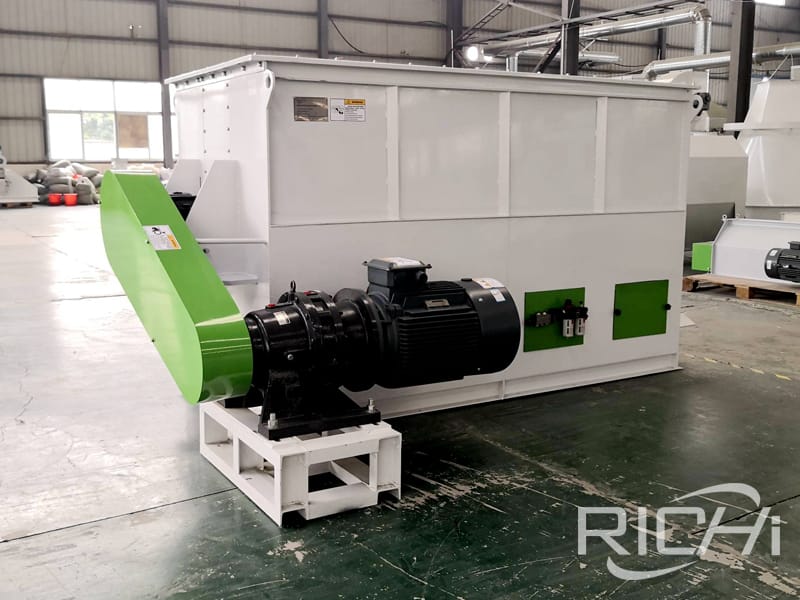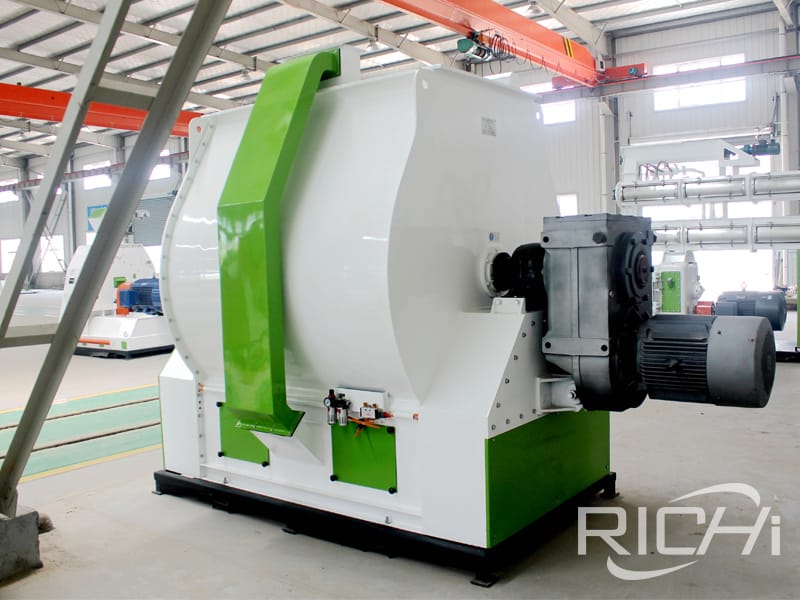Problems that the feed mixer should pay attention to during the mixing process

1. Avoid cross contamination
When a material is transferred from the added material to the feed without the added material, cross-contamination occurs, that is, the remaining batch of feed is mixed into the next batch of feed. For example, if the previous batch of feed contains a high dose of drug, it will cause cross-contamination of the next batch of feed, and in severe cases, the drug concentration in the next batch of feed will exceed the animal's tolerance level. Because all feed passes through the feed mixing machine, the feed mixer mill is an important place for cross-contamination. In order to avoid cross contamination, the following measures are usually taken:
(1) Cleaning.Use a small amount of crushed grain feed and some other harmless or common usable raw materials to clean the mixer to remove potentially harmful drug residues. The cleaned up raw materials containing drug residues must be identified and stored, and added to feed containing the same drug.
(2) Batching in order.The batching in order means to process the feed containing the same drug first, and then process the feed without drug, so that even a small amount of drug cross-contamination will not cause a chain reaction. For example, first produce drug-free feed, then produce high-concentration drug-containing feed, and finally produce low-concentration drug feed, and then produce drug-free feed. In order to apply this method correctly, the operator should have the corresponding professional knowledge and understand where a particular drug can be used and where it cannot be used. Each feed mill should determine the corresponding mixing sequence plan according to the feed product type.
(3) Reduce the static electricity generated during the mixing process. The friction between the powdery material and the main shaft blades of the equipment and the wall of the casing will generate static electricity. Small-size materials (such as drugs) will be adsorbed on the wall of the equipment, affecting the uniformity of mixing and causing drug damage. Cross contamination, prevent the generation of static electricity during the production process. Specific methods include: effectively ground the equipment; add antistatic agents (such as liquid vegetable oils).
(4) Clear adhering feed. Liquid materials are often added during the production. When the liquid is sprayed into the mixed powder, some liquid and powder will stick to the working parts of the equipment. If it is not cleaned in time, it will affect the quality of the product. Produce cross-contamination. The specific measure is to perform manual cleaning regularly. To facilitate cleaning, it is best to use a mixer with a cleaning operation door.

2. Loading capacity of the animal fodder mixer machine
Mixing is a heavy process to determine the output of the entire production line. The mixing time and the loading capacity of the mixer are of concern. The loading capacity of the mixer is an important factor for production volume and production quality.
(1) The paddle mixer is currently a more widely used model, and the mixing volume of each batch has a large variable range, and the mixing volume of each batch is within the range of 40%-140% of the rated mixing volume, and the ideal mixing effect can be achieved.
(2) The maximum feeding amount of the horizontal blade belt mixer should not be higher than the height of the spiral belt, and the minimum feeding amount should not be lower than the height of 10cm above the main shaft of the feed mixer machine.
(3) The vertical mixer has more residual materials and is easy to mix. When changing the formula, clean up the remaining feed in the feed mixer machine.
3. Feed classification phenomenon
The evenly mixed feed will be classified during transportation, which will affect the product quality. In mixed feed, feed classification refers to the separation of one or several feed ingredients or raw material fragments from other raw materials in the mixed feed. The phenomenon of feed classification may occur during feed storage, processing and transportation. The classification phenomenon of feed is related to various factors such as the type of machinery, the particle size, shape and density of the raw materials. It can appear in the buffer bin of the mixer, the lifting of the feed, the pneumatic conveying, the storage bin, the finished product bin and the packaging bin. In the processing link.
(1) Reasons for feed classification
① In the buffer bin, there are four reasons: one is the particle classification that falls freely from the mixer into the buffer bin; the other is the air pressure generated during unloading; the third is the vibration of the machine or equipment; the fourth is the electrostatic adsorption.
② In the bucket elevator, there are two main reasons: one is that classification occurs at the discharge port of the bucket elevator; the other is that the bucket of the bucket elevator is worn out or there are holes in the bucket.
③In the pneumatic conveyor, there are four main reasons: one is that the material suspension speed is different to cause separation; the other is classification in the cyclone dust collector; the third is the classification occurs when the cyclone dust collector falls freely into the silo; Fourth, the feed stacking angle causes the classification of raw materials with different particle diameters.
④In the storage bins, finished product bins, bulk bins and bagged feed packing bins, there are four main reasons: one is that the feed is classified when it falls freely in the air; the other is that the feed forms a chimney in the bin when unloading. Grading occurs in the shaped channel; the third is the classification of feed particles by the vibration of machinery or equipment; the fourth is the electrostatic adsorption.
⑤In bulk trucks, there are three main reasons: one is that the feed is classified when it falls freely in the air; the other is that the airflow speed and the speed of the unloading auger of the truck will cause the feed particles to be classified; the third is that it is in the silo when unloading. A chimney-shaped channel is formed in the grading. Another classification is the classification of powdered feed in the bulk truck due to vibration during transportation.
⑥ In the dust removal equipment, there are two main reasons: first, when the air flow rate of the dust removal equipment is high, the fine powder feed is especially easy to be sucked away, causing the feed to be classified; second, the collected dust cannot be completely mixed into the feed.
It can be seen that the particle size, shape and density of the powdered raw materials are the main reasons for the classification of feed. When the feed particle size disparity is large, it is easy to separate in the mixing stage. For example, mixing whole corn and mineral raw materials such as salt or stone powder is prone to classification. When the raw material falls in the air, the shape of the raw material particles is very important to the classification. Flat pellets fall slowly and tend to stay where they land; round feed pellets fall faster and are not easy to stay where they land. For example, the dried grains and round pellets are mixed together and then dropped into the silo. High-density feed (such as stone powder) is less affected by free fall than low-density pellets (such as grain). Low-density particles are easily carried to the wall of the storage bin by the air flow.
The size, shape and density of different feed pellets influence each other in many ways. For example, if the feed formulation requires a large, flat, low-density raw material to be mixed with a small, three-dimensional, high-density raw material, it is prone to grading if it is shaken during the mixing process, storage and processing. If you add some raw materials with different particle sizes, properties and densities, the degree of classification will be reduced. Liquid raw materials such as water and oil can also be added to make the raw materials better bond together and reduce the occurrence of classification.
(2) Measures to prevent the occurrence of classification
There are two main ways to reduce the classification. One is to minimize the difference in particle size, shape and density between raw materials. Therefore, during feed processing, we must pay attention to the shape, density and crushing particle size of the raw material particles to meet the requirements. The second is to add liquids such as molasses, grease or water to the feed formula to bind particles of different sizes together. However, liquid feed should be added after the dry feed is completely mixed. Adding liquid feed can also cause some problems. For example, the feed may stick to the inner wall of the equipment, silo, auger and mixer, which increases the difficulty of cleaning the equipment and may cause cross-contamination, especially when processing drug-added feed.
In addition, some liquids may reduce or destroy the nutritional value of certain trace components such as trace elements, vitamins and other nutrients. In order to prevent grading due to conveying after the feed is mixed, the following aspects should be paid attention to in the selection of conveying equipment. The horizontal conveying under the buffer bin generally does not use screw conveyors, but uses self-cleaning scraper conveyors. The purpose is to reduce Small grading and residue, and the powdery materials after mixing are prohibited to use dilute phase pneumatic conveying.
Richi Machinery animal feed mixer for sale:
1.small animal feed mixer(250KG/BATCH)
2.single-shaft 500kg/batch animal feed mixer(500KG/BATCH)
3.Popular high quality horizontal manual feed mixer(500KG/BATCH)
4.1ton feed mixer(1000KG/BATCH)
5.feed powder mixer 1.5ton(1500KG/BATCH)
6.Big capacity feed mixer(2000KG/BATCH)
If you want to built one complete pellet production line in your country, pls send the inquiry to us. We will customized design according to your requirement.



